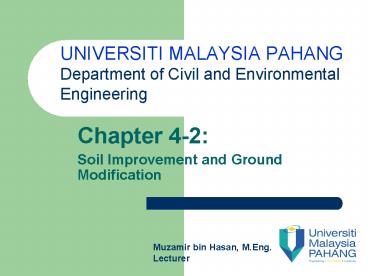Soil Improvement and Ground Modification PowerPoint PPT Presentation
1 / 22
Title: Soil Improvement and Ground Modification
1
UNIVERSITI MALAYSIA PAHANG Department of Civil
and Environmental Engineering
- Chapter 4-2
- Soil Improvement and Ground Modification
Muzamir bin Hasan, M.Eng. Lecturer
2
Sand Drains
- Is another way to accelerate the consolidation
settlement of soft, normally consolidated clay
layers and achieve precompression before the
construction of desired foundation. - Sand drains are constructed by drilling holes
through the clay layers in the field at regular
intervals. The holes are then backfilled with
sand.
3
Sand Drains
- This can achieved by several means, such as-
- Rotary drilling and then backfilling with sand.
- Drilling by continuous flight auger with hollow
stem and backfilling with sand. - Driving hollow steel piles.
4
Sand Drains
- The soil inside the pile is then jetted out after
which backfilling with sand is done. - After backfilling the drill holes with sand, a
surcharge is applied at the ground surface. - This surcharge will increase the pore water
pressure in clay. - The excess pore water pressure in the clay will
be dissipated by drainage both vertically and
radially to the sand drains which accelerates
settlement of the clay layer.
5
Sand Drains
6
Sand Drains
7
Prefabricated Vertical Drains (PVDs)
- Also known as wick or strip drains, were
originally developed as substitute for commonly
used sand drain. - With the advent of material science, these drains
are manufactured from synthetic polymers such as
polypropylene and high density polyethylene. - PVDs are normally manufactured with a corrugated
or channeled synthetic core enclosed by a
geotextile filter.
8
Prefabricated Vertical Drains (PVDs)
- Installation rates reported in the literature are
on the order of 0.1 to 0.3 m/s, excluding
equipment mobilization and setup time. - PVDs have been used extensively in the past for
expedient consolidation of low permeability soils
under surface surcharge. - The main advantage of PVDs over sand drain is
that they do not require drilling and thus,
installation is much faster.
9
Prefabricated Vertical Drains (PVDs)
10
Prefabricated Vertical Drains (PVDs)
11
Prefabricated Vertical Drains (PVDs)
12
Prefabricated Vertical Drains (PVDs)
13
Prefabricated Vertical Drains (PVDs)
14
Prefabricated Vertical Drains (PVDs)
- The Consolidation Problem
- The design of structures on soft compressible
soils (clays) has created problems for owners,
engineers and contractors. Construction without
soil treatment is usually impractical due to
unpredictable long-term settlement. Simple
surcharging as a soil consolidation method can
take many years. Soil consolidation using PVDs
can rapidly increase settlement rates and cut
project durations drastically.
15
Prefabricated Vertical Drains (PVDs)
- What are PVDs?
- PVDs are installed vertically to depths
exceeding 200 feet (65 meters). The water, under
pressure in excess of hydrostatic, flows through
the filter fabric of the PVDs and into the
channels of the PVDs core where it can flow
vertically out of the soil. This flow may be
either up or down to intersecting natural sand
layers or to the surface where a sand drainage
blanket or prefabricated horizontal strip drains
are provided. The water in the soil has only to
travel the distance to the nearest PVDs to reach
a free drainage path.
16
Prefabricated Vertical Drains (PVDs)
- The PVDs core is made of high quality flexible
polypropylene which exhibits a large water flow
capacity in the longitudinal direction of the
core via preformed grooves or water channels on
both sides of the core. Each PVDs can provide a
greater vertical discharge capacity than a 6 inch
diameter sand column.
17
Prefabricated Vertical Drains (PVDs)
- The PVDs core is tightly wrapped in a geotextile
filter jacket of spun-bonded polypropylene which
has a very high water permeability while
retaining the finest of soil particles. Both the
core and geotextile filter jacket have high
mechanical strength, a high degree of durability
in most environments, and high resistance to
chemicals, micro-organisms, and bacteria.
18
Prefabricated Vertical Drains (PVDs)
- How are PVDs designed?
- The PVDs are usually placed in a triangular
configuration of 3 to 12 feet (1 to 4 meters) -
depending on the desired consolidation time. As a
result of this method of accelerating the
consolidation process, uneven post-construction
settlements can be virtually eliminated.
19
Prefabricated Vertical Drains (PVDs)
20
Prefabricated Vertical Drains (PVDs)
21
Prefabricated Vertical Drains (PVDs)
22
Prefabricated Vertical Drains (PVDs)

